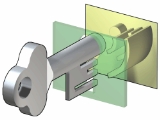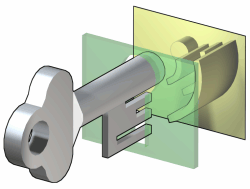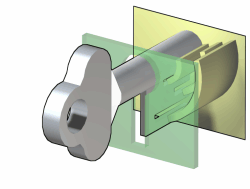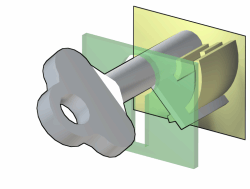
Warded lock
Encyclopedia
 |
 |
 |
A warded lock (also called a ward lock) is a type of lock
Lock (device)
A lock is a mechanical or electronic fastening device that is released by a physical object or secret information , or combination of more than one of these....
that uses a set of obstructions, or wards, to prevent the lock from opening unless the correct key is inserted. The correct key has notches or slots corresponding to the obstructions in the lock, allowing it to rotate freely inside the lock. Large warded locks are still in use today in the UK and Ireland for internal and external doors. Warded locks in America are commonly used in inexpensive padlock
Padlock
Padlocks are portable locks used to protect against theft, vandalism, sabotage, unauthorized use, and harm. They are designed to protect against some degree of forced and surreptitious entry.- History :...
s, cabinet locks, and other low-security applications, since a well-designed skeleton key
Skeleton Key
Skeleton Key is a rock band based in New York City. The band is the brainchild of bassist and singer Erik Sanko, who is the only constant member of the band...
can successfully open a wide variety of warded locks.
History
The warded lock is one of the most ancient lock designs still in modern use. During the Middle Ages they were used prolifically on monasteries where, because money and time were not issues, their complexity grew, but all had the same inherent problem: by removing most parts of the key the wards could be bypassed.Design
In the most basic warded lock, a set of obstructions, often consisting of concentric plates protruding outwards, blocks the rotation of a key not designed for that lock. Warded locks may have one simple ward, or many intricate wards with bends and complex protrusions; the principle remains the same. Unless the notches or slots in the key correspond to the wards in the lock, the key will strike an obstruction and will not turn.Additionally, a series of grooves on either side of the key's blade limit the type of lock the key can slide into. As the key slides into the lock through the keyway
Keyway
A keyway is the shaped channel in a lock cylinder into which the key slides to gain access to the lock tumblers. Lock keyway shapes vary widely with lock manufacturer, and many manufacturers have a number of unique profiles requiring a specifically milled key blank to engage the lock's...
, the wards align with the grooves in the key's profile to allow or deny entry into the lock cylinder
Cylinder (geometry)
A cylinder is one of the most basic curvilinear geometric shapes, the surface formed by the points at a fixed distance from a given line segment, the axis of the cylinder. The solid enclosed by this surface and by two planes perpendicular to the axis is also called a cylinder...
. Although this is not commonly recognized when discussing warded locks, it is more applicable to current locksmithing
Locksmithing
Locksmithing began as the science and art of making and defeating locks. A lock is a mechanism that secures buildings, rooms, cabinets, objects, or other storage facilities. A key is often used to open a lock...
applications such as pin-tumbler
Pin tumbler lock
The pin tumbler lock is a lock mechanism that uses pins of varying lengths to prevent the lock from opening without the correct key...
or wafer-tumbler
Wafer tumbler lock
A wafer tumbler lock is a type of lock that uses a set of flat wafers to prevent the lock from opening unless the correct key is inserted. This type of lock is similar to the pin tumbler lock and works on a similar principle. However, unlike the pin tumbler lock, the wafer is a single piece...
locks.
In double sided locks the centre of the key shaft is solid and protrudes past the end of the bit
Bitting
A bitting is the part of the key that actually engages the tumblers to activate the lock. Bittings are often represented as a code which instructs how a key is to be cut by a locksmith. The bitting is usually a series of integers that is usually translated from a key code chart or from a...
which slots into a hole on the opposite side of the lock. Double sided ward locks nearly always have perfectly symmetrical bits. For single sided locks a cylindrical post is typically located in the center of the lock. Its purpose is to provide a point of leverage for rotating the key, and to help correctly align the key with the wards. The key has a corresponding hole which fits over the post.
When the correct key is inserted, it will clear the wards and rotate about the center post. The key may then strike a lever, activating a latch or sliding bolt, or it may itself push against the latch or bolt. In a double acting lever lock
Lever tumbler lock
A lever tumbler lock is a type of lock that uses a set of levers to prevent the bolt from moving in the lock. In the simplest of these, lifting the tumbler above a certain height will allow the bolt to slide past. The number of levers may vary, but is usually an odd number for a lock that can be...
, the key may additionally push against a spring-loaded lever which holds the sliding bolt in place.

